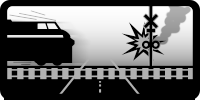Activation Failure

The failure of signal equipment at a railroad crossing to activate(gates down or lights flashing) to warn a driver of an oncoming train. (CFR, Title 49, Chapter II, Part 234, Subpart C, Sec. 234.105). (It is the sole responsibility of the railroad company owning the crossing to ensure the signal equipment is working properly according to federal mandates.
Railroad companies are also responsible for maintenance of all signal equipment installed at railroad grade crossings). In addition to filling out an Angels on Track Dangerous Crossing Report, citizens should contact their police or sheriff departments to document the hazard, each occurrence. Law enforcement should then call the railroad company owing the crossing to report the danger. This will document a pattern of system failures or malfunctions locally, especially if the railroad has been contacted and does nothing to fix or eliminate the danger.
Upon receipt of a report of a warning system activation failure, the railroad company having maintenance responsibility for the warning system shall promptly
Initiate efforts to warn highway users and railroad employees at the crossing by taking the following actions:
1. Prior to train’s arrival at crossing, notify the train crew of the activation failure and notify any other railroads operating over the crossing.
2. Notify law enforcement having jurisdiction over the crossing, or railroad police capable
of responding and controlling vehicular traffic and,
3. Provide for an alternate means of actively warning highway users of approaching trains
by: Flagging the crossing (each direction) for vehicular traffic. Trains may proceed through crossing at normal speed.
4. Local law enforcement or railroad police provide warning to vehicular traffic. Trains may
proceed at normal speed.
5. If only one uniformed law enforcement or railroad police officer provide warning to
highway traffic at crossing, trains may proceed with caution through the crossing at
speed not exceeding 15 miles per hour. Normal speed may be resumed after locomotive
has passed through the crossing.
6. If no flagger at crossing, each train must stop before entering the crossing and permit a
crew member to dismount to flag the highway traffic to a stop. STOP & FLAG
7. A locomotive’s audible warning device is activated in accordance with railroad rules
regarding the approach to a grade crossing.
"Bad Crossings Kill Good Drivers"®
